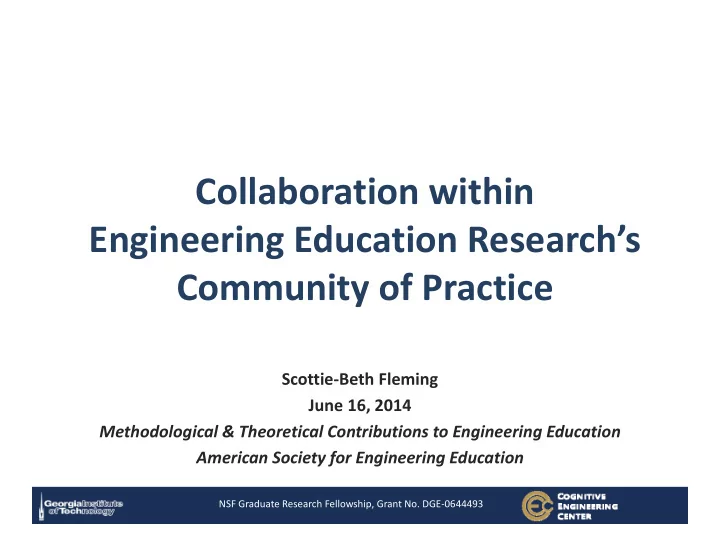

Collaboration within Engineering Education Research’s Community of Practice Scottie ‐ Beth Fleming June 16, 2014 Methodological & Theoretical Contributions to Engineering Education American Society for Engineering Education NSF Graduate Research Fellowship, Grant No. DGE ‐ 0644493
Engineering Education Research (EER) as an Interdisciplinary Field Multidisciplinary distribution of expertise and backgrounds Common themes of interdisciplinary collaboration Recent emergence of specialized EER labs, centers, and departments Borrego & Newswander, 2008; Borrego & Bernhard, 2011; Borrego 2007; 2 Jesiek, Newswander & Borrego, 2009
Examine collaboration patterns within the Engineering Education Research (EER) community of practice How does the availability of formal, on ‐ campus EER resources impact collaboration? Are EER knowledge and expertise resources being effectively leveraged throughout our community of practice? 3
Methodology: Social Network Analysis Quantitatively and qualitatively describes hidden social interaction patterns Co ‐ authorship indicates formal collaboration patterns Symbol shape, size, and color indicate specific data attributes Line thickness indicates frequency of interaction 4 Kadushin, 2012; Borgatti, Everett, & Johnson, 2013
Data Source Journal of Engineering Education o Impact Factor: 1.925 Years 2008 ‐ 2012 Imported from Web of Science Cleaned in VantagePoint 146 articles by 394 authors Attributes University/Organization Organization Type Academic Department Number of Articles Number of Times Cited Availability of EER Resources o Engineering Education Department o EER ‐ Devoted Center o No Formal EER Resources
Attribute # Orgs # Authors # Pubs EER ‐ Oriented Department 5 68 51 Eng/STEM Ed Research Center 18 124 62 No Formal On ‐ Campus Resources 90 174 93 80% 47% 45% 30% 34% 25% 16% 19% 4% 6
Network Importance & Influence Availability of EER resources is not significant F(2, 363)=0.830, p>0.05 Top 10 ranked authors primarily have access to EER resources Degree EER # JEE Centrality Author University Resources Affiliation Articles 2.5 Ohland, M. Purdue Department Engineering Education 8 1.7 Finelli, C. Michigan Center Engineering Education 5 1.7 Sheppard, S. Stanford Center Designing Education Lab 4 1.6 Borrego, M. Virginia Tech Department Engineering Education 10 1.2 Chen, H. Stanford Center Designing Education Lab 3 1.2 Diefes ‐ Dux, H. Purdue Department Engineering Education 5 1.2 Long, R. Purdue Department Engineering Education 3 1.1 Carpenter, D. Lawrence No Formal Civil Engineering 3 1.1 Harding, T. Calif Poly No Formal Materials Engineering 3 1.1 Lichtenstein, G. Stanford Center Designing Education 3 7 2014 ASEE Annual Conference & Exposition
Bridging Collaboration Gaps or, Connecting Other Researchers High Betweeness Centrality indicates that an individual is bridging connections between researchers Availability of EER resources is significant: F(2, 332)=11.204, p<0.001 8 2014 ASEE Annual Conference & Exposition
Collaboration Outside & Inside My Network Range varies from ‐ 1 to +1 o +1: authors tend to collaborate with others outside their network o ‐ 1: authors tend to collaborate with others inside their network Availability of EER resources is significant: F(2, 91) = 9.715, p<0.001 9 2014 ASEE Annual Conference & Exposition
Network Map: Organized by University Universities with EER departments tend to be more Availability of EER Resources (Color) central to network Pink Engineering Education Depart Universities with formal EER centers are further out Blue STEM Education Research Center Universities with no formal EER resources tend to Black No Formal EER Resources Grey/Green No Code be scattered on the edges 10 2014 ASEE Annual Conference & Exposition
Summary Researchers with access to an engineering education department are central and influential collaborators within EER Researchers without access to formal EER resources have inadequate access to ‘expert’ EER network Collaboration among researchers on campuses with formal EER centers aren’t distinguishable from those who don’t have access to formal resources 11 2014 ASEE Annual Conference & Exposition
Future Questions for the Community How can we better support access to EER “expert” community of practice? How can we create more opportunities for formal collaboration between institutions? What is the goal of formal EER centers? What is the impact of “informal” collaboration & mentorship? 12 2014 ASEE Annual Conference & Exposition
Acknowledgements The work is supported by the National Science Foundation Graduate Research Fellowship under Grant No. DGE ‐ 0644493 Dr. Julia Melkers (SNA Methodology) Dr. Alexandra Coso (EER Background and Community) 13 2014 ASEE Annual Conference & Exposition
Recommend
More recommend